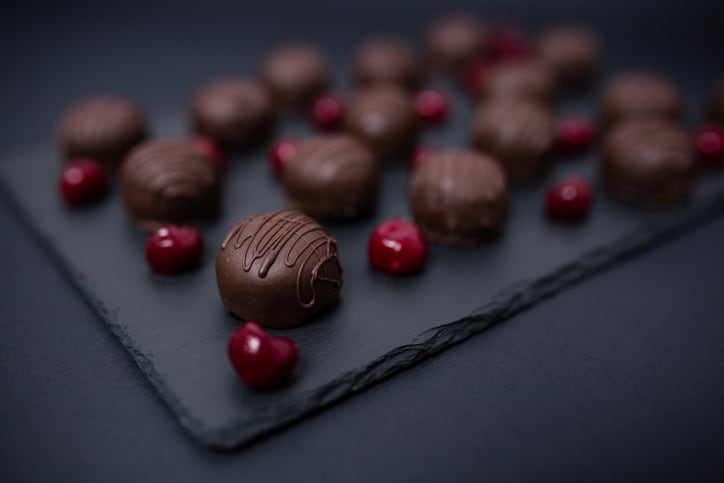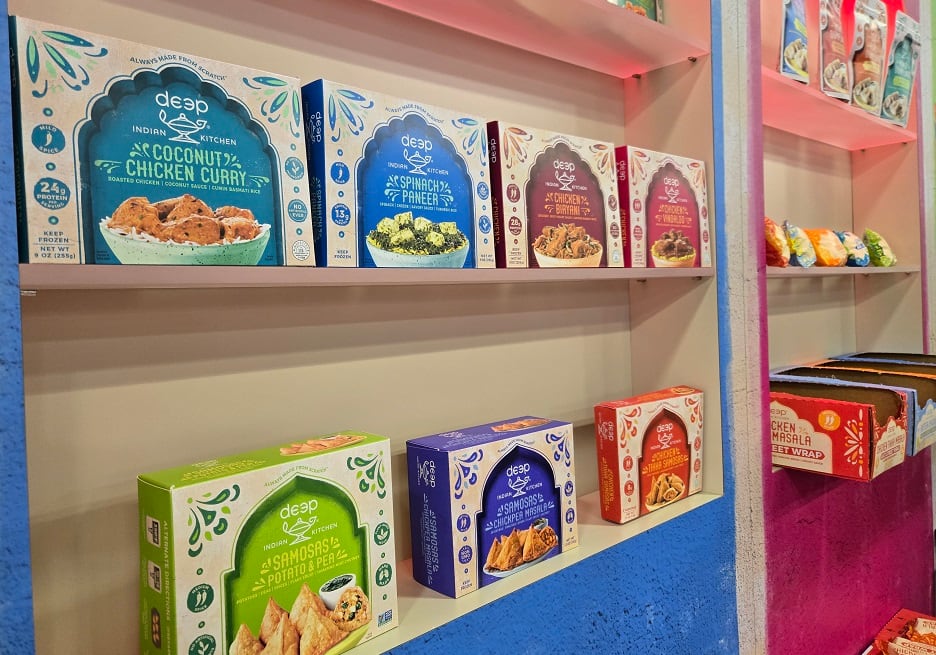Volatile cocoa prices and sourcing challenges have cast a long shadow over the chocolate category, but there are still plenty of bright spots driving growth, inspiring innovation and instilling long-term confidence in the segment.
According to Innova Market Insights, nearly two-thirds of the global population bought chocolate in 2024 with more than half eating it weekly and 54% gravitating to bars and truffles. This helped drive revenue in the chocolate confectionery market to $140.12 billion in 2025, according to Statista, which projects the market will continue to grow at a compound annual growth rate of 4.89% through 2030.
To meet consumer demand and further drive growth, chocolatiers once again are innovating after a brief pause during the COVID pandemic. According to Innova, confectionery launches increased more than 3% year over year between 2018 and 2022.
In this episode of FoodNavigator-USA’s Soup-To-Nuts podcast, chocolatiers share what consumers want, how they are meeting their demands and where they see the most potential, including better-for-you products with clean labels, functional benefits and alternative sweeteners, as well as bold flavor combinations, vibrant packaging and products that skip cocoa solids and let cocoa butter shine. They also talk strategy for navigating price and supply volatility of cacao, cocoa solids, cocoa butter and other key ingredients.
Explore past episodes of Soup-To-Nuts podcast
Never miss an episode of FoodNavigator-USA’s Soup-To-Nuts podcast, or our recently launched Founders' Fundamentals podcast - subscribe today.
Catch up on past episodes of Soup-To-Nuts:
- Flavor trends: How to balance authenticity and access when introducing global dishes - Consumers says they want adventurous new flavors and international cuisine, but many are hesitant to try something unfamiliar - creating a 'conundrum' for manufacturers and marketers introducing global flavors
- What is driving consumer interest in regenerative agriculture? – Consumer awareness and interest in regenerative agriculture is exponentially increasing - placing pressure on farmers, manufacturers and retailers to work together to boost supply
- Danone seeks to rekindle consumers’ love of plant-based milk – Sales of plant-based milk have slowed in the past year, but Silk and So Delicious maker Danone still sees significant potential by focusing on fun in addition to function
- What attracts consumers to whole grains and where is there room for innovation? – As the Whole Grain Stamp celebrates its 20th anniversary, Oldways Whole Grain Council considers where there is room for innovation and how to overcome barriers blocking product development and consumption of whole grains
- Better-for-you marketing claims raise red flags: Could enforcement crackdown loom? - An advertising watchdog lists ‘better-for-you’ claims as a potential enforcement area for 2025 amid concerns that marketers may not be able to support implied health claims
Shoppers want chocolate with low- or no-sugar and clean ingredient decks
Chocolate has long been touted as a “superfood” thanks to the high levels of antioxidants in cacao that some research suggests could offer heart health benefits, but these benefits often are tempered by high amounts of added sugar, fat and inclusions that tip chocolate into the indulgent category.
In recent years, however, consumers increasingly are interested in better-for-you chocolate.
According to research by the ingredient supplier Puratos, in 2024 there were more than 1.2 million online conversations and searches related to chocolate and confections with “a balanced mix of macronutrients.” Research by Barry Callebaut backs up the trend with a survey that found 53% of North American consumers think that chocolate products should offer more than taste – they also need to align with their health needs, which increasingly means lower sugar or no added sugar.
To meet this demand, a new generation of chocolatiers are creating products without refined sugar, including Good Girl Chocolate, which founder and naturopathic doctor Tabatha Carr explained offers “a chocolate for everyone.”
Her chocolate is free from gluten, dairy and soy and is sweetened with organic coconut sugar.
Coconut sugar is a popular alternative to cane sugar favored by several brands, including startup Celia Chocolatier. Rhonda Nassar, who founded the company with her sister Dinah, explained coconut sugar has a lower glycemic index score and better aligns with the broader clean label movement, which also heavily influences Celia Chocolatier.
“A lot of our customers are the ones looking for clean. For instance, the reviews you would see some of our customers are saying ‘We eat lower on the food chain,’ and they like that it is vegan. So, our chocolates don’t have dairy in them. They are all simple ingredients and they taste really premium,” Nassar said.
She added Celia Chocolatier also does not use palm oil or added butter, is free from additives and preservatives and uses organic ingredients, although the bars are not yet certified.
Spring & Mulberry forgoes all added sugar by using whole dates to sweeten its line of dark chocolate bars, which co-founder Catherine Shah notes sets the bars apart from the competition.
“We stand out in a few ways. One is just a very, very simple, clean ingredient list. Our ethos is everything, all ingredients that we use, come from the earth or that you find in a produce aisle, and then the dates, obviously are a key component of our brand. Dates are packed with antioxidants. They have more antioxidants than blueberries and more potassium than bananas. But what is key in terms of managing insulin and blood sugar spikes is that they are full of fiber, which slows the absorption of sugar in the body,” Shah said.
Shah adds Spring & Mulberry’s products also are crafted to meet emerging demand for simple, clean ingredients.
“We find that our consumers are generally looking to us for two things. One is they’re trying to reduce sugar in their diet for a whole host of reasons, whether it is lifestyle or medical, but they are also looking to us because they want simple ingredients from the earth. They want to look at their ingredient panel and see dates, cocoa beans, berries, florals, nuts, like things that are actually grown on a farm and not in a lab,” she said.
Clean label 2.0: Join our webinar
Interested in learning more about how clean label trends are evolving and reshaping different food and beverage categories? Join FoodNavigator-USA and a panel of experts at our upcoming free editorial webinar April 16.
During the 60-minute event, Clean label 2.0: Soothing safety concerns and navigating state bans, representatives from Mintel, a leading law firm and two brands in the baby food and salad dressing aisle will explore how the demand for 'clean-label' is evolving among consumers, legislators and regulators - and how brands are innovating and renovating to meet their needs.
Learn more and register today.
Adventurous flavors and functional benefits drive trial and repeat purchase
The addition of berries, florals, nuts and botanical oils in Spring & Mulberry’s and Celia Chocolatier’s chocolate bars also help the brands meet rising consumer demand for ingredients with functional benefits and which offer adventurous taste experiences.
According to Innova Market Insights, “adventurous consumers are on the lookout for new chocolate flavors and experiences to challenge their preferences.”
One rising ingredient that checks both boxes is ube – a bright purple tuberous root vegetable from the Philippines that has a slightly sweet, nutty profile that plays well with other flavors and which is touted as packed with vitamins, minerals and antioxidants that support eye and heart health as well as immunity.
Hawaii-based Galleon Chocolate prominently features ube in its products, which founder Len Gonzales said are inspired by his Filipino culture.
“People who are looking for a taste adventure or a connection back to the Philippines could actually get that feeling, that vibe, with all our products,” he said.
He explained ube’s flavor profile is of pistachio, vanilla and some undercurrents of coconut.
“Imagine a white chocolate bar with those flavor profiles, but vibrant purple, naturally colored from the ube yam powder that we use. You get the stunning purple, vibrant color with most of our products,” he said.
Coba, which makes coffee and tea infused white chocolate bars, also is tapping into consumer demand for functional benefits and new flavor experiences. Company Co-Founder Peter Lee explains that each Coba bar is equal to one cup of tea or coffee, depending on the flavor, and offers a multi-phased tasting experience.
“We are essentially brewing the coffee and teas in cocoa butter” to create the coffee shop experience in a chocolate bar that is portable, he said.
For example, Coba offers a double espresso bar with two shots of espresso and the smooth texture of cocoa butter.
“When you first bite into it, you are getting mostly the chocolate texture and then espresso with slowly release itself and it will resemble a Cuban espresso with roasting notes of the coffee and with the brown sugar notes you get after that,” he explained.
The company’s matcha latte bar offers a “subtle flavor,” while the chai latte bar packs a sinus clearing punch paired with sweet notes, he added.
White chocolate rises alongside cocoa prices
Coba’s and Galleon Chocolate’s decision to use white chocolate – or just the cocoa butter – as the base for their products was equally an economic decision as it was a culinary one.
Lee explained that with cocoa prices rising quickly, he wanted to manage input costs by using less cocoa solids, which are more expensive than cocoa butter.
Like Coba, Galleon Chocolate predominantly uses cocoa butter to create white chocolate to keep costs down, but it also is mitigating rising cocoa costs by using more inclusions to stretch the cocoa.
Celia Chocolatier and Spring & Mulberry are keeping their product prices down despite rising input costs from cocoa by improving production and identifying other cost savings within their businesses.
Bright colors and whimsical illustrations help new generation of chocolate standout
While what is inside each bar may matter most to consumers, the outside – including packaging, merchandising and the appearance of the bars – also heavily influences trial and repeat purchase.
As such, some chocolate brands are embracing more colorful packaging to standout on shelf and carefully decorating chocolate to elevate the eating experience.
Celia Chocolatier and Spring & Mulberry, for example, layers nuts, flower petals, coconut, dried fruit and other premium flavoring ingredients on top of the bars for enhanced visual appeal. Both brands also feature clear windows so consumers can see the bars on shelf.
To help Spring & Mulberry further pop on shelf, Shah said the brand opted to skip the earth tones commonly used by chocolate brands and instead use jewel tones, which she added better resonates with female shoppers.
Galleon Chocolate’s packaging also stands out with whimsical illustrations of an imaginary land and unique opening mechanism that Gonzales says was inspired by the unboxing experience of high-end phones and tablets.
“Most chocolate packages open from the back or from the top in a little box. We wanted our chocolate to open from the front so people could admire and appreciate the” hexagonal shape of the bar and the bright color of ube, Gonzales explained.
Ultimately, eating chocolate should be a fun, multi-sensory experience, the companies agreed. And even though many modern trends favor healthier options that does not mean the products need to taste like health food or have a diminished appearance. They all reiterate their products can be better-for-you and still taste and look pleasing.




